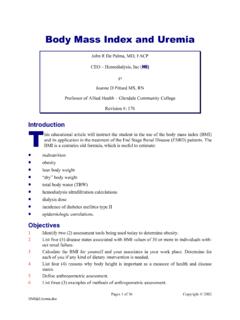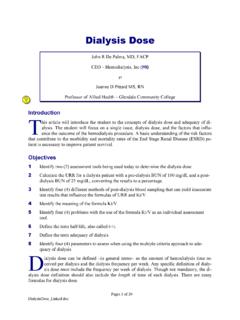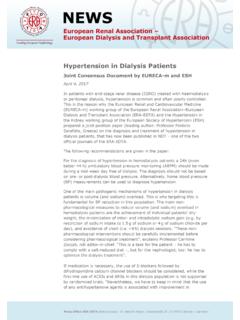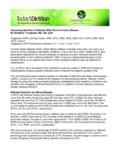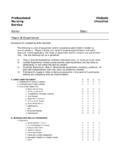Transcription of Body Water - Body Weight - Hemodialysis, Inc
1 body Water body Weight John R De Palma, MD, FACP CEO hemodialysis , Inc (Hi) Joanne D Pittard MS, RN Professor of Allied Health Glendale Community College Revision #: 164 T Introduchis educational article discusses the concepts of body Weight body Water . These two (2) concepts which should be mentally inseparable when planning the hemodialysis proce-dure. body Water is the most abundant single substance in the body in the normal, healthy adult. A basic, simple, and clear understanding of body Weight body Water should be essential for all who care for End Stage Renal Disease (ESRD) patients. tion Proper control of body Weight body Water , like dialysis dose, is one of the important issues and risk factors that contribute to the morbidity and mortality of ESRD patients.
2 Without knowledge of body Weight body Water the health-care giver can not render adequate dialysis care. In a hemodialysis facility, the classic four vital signs of: temperature, pulse, respirations, and blood pressure should be supplemented with the patient s actual Weight both pre and post dialysis. Objectives 1 2 3 4 5 6 7 8 List the percentages of the total body Water for the two (2) principal compartments. Describe the two principal (2) body fluid compartments. Explain transcellular Water . Describe the term third space fluid accumulation. State what percentage of total body Water accounts for total body Weight in the following: lean adult male, obese woman, and infant. Differentiate between hypotonic, hypertonic and isotonic solutions. What does the serum sodium (Na+) indicate regarding total body Water ?
3 Describe four (4) signs and/or symptoms of extracellular volume (ECV) excess. hemodialysis , Inc Pages 1 of 25 Copyright 2001 body Water - body Weight Friday September 21, 2001 9 10 11 12 Identify the major cause of hypertension in more than 90% of the ESRD patient popula-tion. Identify the rationale for not allowing some patients to eat during their dialysis treatment. Describe the relationship with the serum glucose and the serum sodium. Identify the correction factor for the serum sodium (Na+) when a patient is hyperglyce-mic. W Total Bodyater is the single most abundant substance in the normal human body . Water can be said to be very stuff of life. Water is almost a universal solvent. A true universal sol-vent can not be kept in a container. A true universal solvent would dissolve its con-tainer, leak downward, pulled by the force of gravity, and fall to the center of the earth.
4 There it would remain until the end of the earth s time. Water is not a universal solvent, if it were, we would not exist as Water soluble, carbon based beings. Water (TBW) Figure 1 - Total body Water TBW Compartments Most body water1 is contained inside of tissue and muscle cells. This is intra-cellular Water . Fat cells, cells used to store almost Water -free fat, contain much less Water , on the order of ten per-cent (10%) of the Water in muscle, skin or other cells. A BMI of thirty (30) or more, see Equation 7, is defined as morbid obesity. Morbid obesity causes a falsely high TBW. body fat contains very little Water . hemodialysis , Inc Pages 2 of 25 Copyright 2001 body Water - body Weight Friday September 21, 2001 Extra-cellular Water (ECV) The Water outside of cells is called extra-cellular Water and is composed of Water between cells (interstitial Water ) and plasma Water .
5 Figure 1 is a drawing of the total body Water (TBW) compartments of an idealized 70 kilogram (Kg) healthy, normal, adult male. In this example, we use a TBW of sixty percent (60%) of body Weight rather than the more difficult to calculate and remember though scientifically more pre-cise fifty-eight percent (58%). The TBW is composed of the intra-cellular Water which is two-thirds (2/3) of the TBW or 28 liters; and the extra-cellular Water which represents one-third (1/3) or 14 liters. The total TBW is forty-two (42) liters. The TBW is remarkably constant; though the range in a group of individuals of both sexes and all ages varies from forty to seven-five percent (40 - 75%) of body Weight . The TBW is closely related to muscle mass. An estimate of lean body mass can be easily ob-tained if the TBW is actually measured.
6 Muscle and tissue cells the major components of lean body mass are about seventy-three percent (73%) Water . If the individual s TBW is 42 liters then his/her lean body Weight or mass of body muscle and non-fat cells is (42/73%) or kilograms, see Equation 1. Lean body Weight = Equation 1- Lean body Weight Trans-cellular Water There is a small amount of Water , one to three percent (1 - 3%) of TBW called trans-cellular wa-ter which exists in various body compartments: cerebrospinal intra-ocular pleural peritoneal gastro-intestinal (GI) tract. Except for the GI tract fluid, these watery spaces are tiny, virtual quantities of fluid in the normal state. In the abnormal state, transcellular Water can contain large volumes of fluid which are clinically given the term third space fluid accumulation.
7 In non-dialysis normal medical par-lance, third spacing of fluid is associated with pathology as minor as a traumatic knee effusion to as major as massive ascites due to fulminant pancreatitis. Transcellular Water is different in composition from extracellular Water because the transcellular spaces are separated from the blood plasma not only by a layer of capillary endothelium but also by another layer consisting of cells which modify the amount and composition of the transcellular fluid. hemodialysis , Inc Pages 3 of 25 Copyright 2001 body Water - body Weight Friday September 21, 2001 Third Space Figure 2 is a drawing of the TBW compartments.
8 It depicts how little transcellular Water contrib-utes to the total Water volume as well as denoting that the transcellular compartment is the third space. In Figure 1, the intra-cellular Water (IC) can be referred to as the first space. The extra-cellular Water (EC) is called the second space. The third space is an abnormal accumulation of Water outside of these two spaces. Except for the GI tract during active digestion, the normal amount of Water contained in the trans-cellular Water compartments is very small. Peritoneal Dialysis is Third Spacing Expanding the peritoneal space by instilling one or more liters of high glucose containing fluid is the method used in peritoneal dialysis to remove excess ECV. Unlike hemodialysis , using ul-trafiltration to remove ECV with peritoneal dialysis is impossible.
9 The excess ECV is removed by introduction of a hypertonic glucose solution into the peritoneal space causes extra-cellular fluid to move from blood into the peritoneal space. This excess ECV is removed in the peritoneal dialysis outflow. Since the peritoneal space normally contains only a few milliliters of fluid, this technique induces a third space phenomenon or condition in the patient. hemodialysis ultrafiltra-tion may remove two to three (2 - 3) liters of ECV per hour and subject the patient to substantial hypotension or shock. In peritoneal dialysis, this ECV loss is more gradual and occurs over a twenty-four (24) hour period. Figure 2 - Transcellular Water Whole Blood Is Both Extra-cellular & Intra-cellular Plasma Water is about one-third (1/3) to one-forth (1/4) of the ECV Water .
10 If one uses one-fourth of the fourteen (14) liters of ECV, then that plasma Water volume is (14/4) or liters. Since red blood cells make up the majority of the rest of whole blood, then the volume of whole blood can be calculated by knowing the patient s Hct: hemodialysis , Inc Pages 4 of 25 Copyright 2001 body Water - body Weight Friday September 21, 2001 Blood Volume = Plasma Water1 - Hct Equation 2 - Calculating Blood Volume With a Hct of 35% and a plasma Water of liters, the blood volume is { ( )} or liters. Whole blood contain both intra-cellular and extra-cellular Water . Physiology Rules The physiology and control of the TBW, like all of human physiology, dwarfs mankind s me-chanical devices, computers, and skills.
